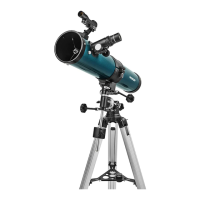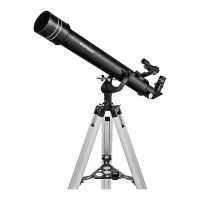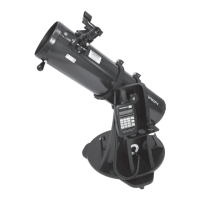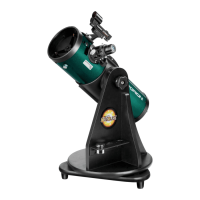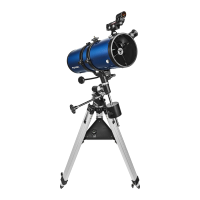13
6. Useful Optional
Accessories
• Moon Filter – A 1.25" Moon lter will cut down the strong
glare of sunlight reected from the Moon, making Moon viewing
more comfortable and revealing more surface detail. The lter
threads into the bottom of the Kellner eyepieces that came with
your telescope (Figure 26).
• Motor Drive – A motor drive, which attaches to the right
ascension axis of an equatorial telescope mount, enables your
telescope to “track” the motion of stars and other celestial objects
as they drift slowly from east to west in the night sky. This keeps
them in the eyepiece eld of view indenitely, instead of drifting
out of sight.
• Barlow Lens – A 2x Barlow lens doubles the magnifying
power of any eyepiece it’s used with, giving you a big power
boost to get in closer to your target object. You just insert it
between the diagonal and the eyepiece.
• Planisphere – A nifty “star wheel” that shows what stars and
constellations are visible in the sky at any time of any night. Just
set the date and time see a mini representation of your local
night sky. Great for identifying what you see and planning an
evening’s observing session.
• Star Map – More detailed than a planisphere, a star map is
essential for locating interesting celestial objects to observe with
your telescope. Nowadays many mobile astronomy apps feature
customizable star maps that you can access on your smart-
phone or tablet while you’re at the telescope.
7. Aligning the Mirrors
(Collimation)
Collimation is the process of adjusting the optics of a tele-
scope so they are precisely aligned with one another and with
the telescope tube. For this reector telescope, the primary
and secondary mirrors must be in precise alignment. Your
telescope’s optics were aligned at the factory, and should not
need much or any adjustment unless the telescope is handled
roughly. Accurate mirror alignment is important to ensure the
peak performance of your telescope, so it should be checked
occasionally. With practice, collimating is relatively easy to do
and can be done in daylight.
It helps to perform the collimation procedure in a brightly lit
room with the telescope pointed toward a bright surface, such
as a light-colored wall. Placing a piece of white paper in the
telescope tube opposite the focuser (i.e., on the other side of
the secondary mirror from the focuser) will also be helpful.
You will need a Phillips screwdriver to adjust the mirrors.
To check your telescope’s collimation, remove the eyepiece
and look down the focuser. You should see the secondary
mirror centered in the focuser, as well as the reection of
the primary mirror centered in the secondary mirror, and the
reection of the secondary mirror (and your eye) centered in
the reection of the primary mirror, as in Figure 22a. Got all
that? Review it again carefully, and compare what you see to
Figure 22a. If anything is off-center, proceed with the follow-
ing collimation procedure.
Reection of
secondary
mirror
Figure 22. Collimating the optics. a) When the mirrors are properly aligned, the view down the focuser drawtube should
look like this. b) If the optics are out of alignment, the view might look something like this (with a collimation cap or Cheshire
eyepiece in place). Here, only part of the primary mirror is visible in the secondary mirror, so the secondary mirror needs
to be adjusted (tilted). c) Here the secondary mirror is correctly aligned because the entire primary mirror is visible in it. But
the reection of the secondary mirror is off-center. So the primary mirror still needs adjustment. d) Now the primary mirror is
correctly aligned, so the secondary mirror is centered.
a.
b.
c.
d.

